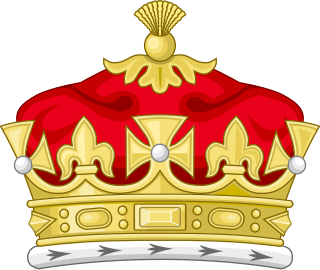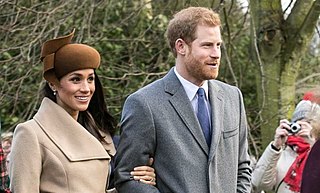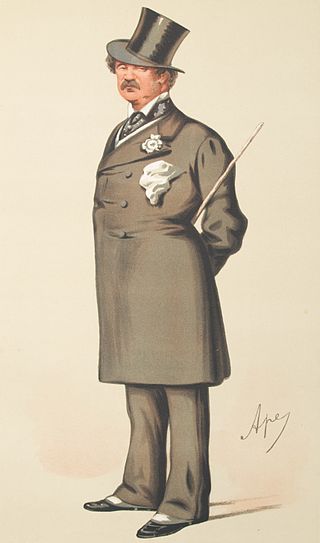
The Royal Marriages Act 1772 was an Act of the Parliament of Great Britain which prescribed the conditions under which members of the British royal family could contract a valid marriage, in order to guard against marriages that could diminish the status of the royal house. The right of veto vested in the sovereign by this Act provoked severe adverse criticism at the time of its passage.

Duke of Clarence was a substantive title created three times in the Peerage of England. The title Duke of Clarence and St Andrews has also been created in the Peerage of Great Britain, and Duke of Clarence and Avondale and Earl of Clarence in the Peerage of the United Kingdom. The titles have traditionally been awarded to junior members of the English and British royal family, and all are now extinct.

Duke of Cambridge is a hereditary title of nobility in the British royal family, one of several royal dukedoms in the United Kingdom. The title is named after the city of Cambridge in England. It is heritable by male descendants by primogeniture, and has been conferred upon various members of the British royal family several times throughout history.

Duke of Sussex is a substantive title, one of several royal dukedoms in the Peerage of the United Kingdom. It is a hereditary title of a specific rank of nobility in the British royal family. It has been created twice and takes its name from the historic county of Sussex in England.

Prince Augustus Frederick, Duke of Sussex, was the sixth son and ninth child of King George III and his queen consort, Charlotte of Mecklenburg-Strelitz. He was the only surviving son of George III who did not pursue an army or navy career. A Whig, he was known for his liberal views, which included reform of Parliament, abolition of the slave trade, Catholic Emancipation, and the removal of existing civil restrictions on Jews and Dissenters.

Charles Seymour, 6th Duke of Somerset, KG, PC,, known by the epithet "The Proud Duke", was an English aristocrat and courtier. He rebuilt Petworth House in Sussex, the ancient Percy seat inherited from his wife, in the palatial form which survives today. According to the Encyclopædia Britannica Eleventh Edition, he was a remarkably handsome man, and inordinately fond of taking a conspicuous part in court ceremonial; his vanity, which earned him the sobriquet of "the proud duke", was a byword among his contemporaries and was the subject of numerous anecdotes; Macaulay described him as "a man in whom the pride of birth and rank amounted almost to a disease".

Baron Burton, of Burton-on-Trent and of Rangemore in the County of Stafford, is a title in the Peerage of the United Kingdom. It was created in 1897 for the prominent brewer, philanthropist and Liberal politician Michael Bass, 1st Baron Burton. He had already been created a baronet in 1882 and Baron Burton in 1886. However, the three titles had different remainders. The Bass family descended from William Bass, who founded the brewery business of Bass & Co in Burton upon Trent in 1777. His grandson Michael Thomas Bass transformed the company into one of the largest breweries in the United Kingdom. He also represented Derby in Parliament as a Liberal for thirty-five years and was a great benefactor to the town of Burton. However, Bass declined every honour offered to him, including a baronetcy and a peerage.

Baron Arklow was a title in the Peerage of the United Kingdom that has been created twice. Arklow is a town in County Wicklow in Ireland.

Charles Lennox, 1st Duke of Richmond, 1st Duke of Lennox, of Goodwood House near Chichester in Sussex, was the youngest of the seven illegitimate sons of King Charles II, and was that king's only son by his French-born mistress Louise de Kérouaille, Duchess of Portsmouth. He was appointed Hereditary Constable of Inverness Castle.

The use of the title of Princess of the United Kingdom of Great Britain and Northern Ireland is entirely at the will of the sovereign, and is now expressed in letters patent. Individuals holding the title of princess will usually also be granted the style of Her Royal Highness (HRH). The current letters patent were issued in 1917 during World War I, with one extension in 2012.

The title of Earl of Inverness is a title of nobility in the Peerage of the United Kingdom. It was first created in 1718 in the Jacobite Peerage of Scotland, together with the titles Viscount of Innerpaphrie and Lord Cromlix and Erne, by James Francis Edward Stuart for the Honourable John Hay of Cromlix, third son of the 7th Earl of Kinnoull. He was created Duke of Inverness in 1727, but both titles became extinct upon the death of the grantee in 1740.

Lord Alfred Henry Paget was a British soldier, courtier and Liberal politician who sat in the House of Commons between 1837 and 1865.

Sarah Lennox, Duchess of Richmond, was Lady of the Bedchamber to Queen Caroline from 1724 to 1737. She was the mother of the famous Lennox sisters.

Cecilia Underwood, Duchess of Inverness was the second wife of Prince Augustus Frederick, Duke of Sussex. Despite marrying, like the Prince's first marriage, their union was in contravention of the Royal Marriages Act 1772 and as such was considered legally void. Consequently, she could not be styled either as the Duchess of Sussex nor a Princess. She was created Duchess of Inverness, in her own right, by Queen Victoria, on 10 April 1840.

Lady Augusta De Ameland was a Scottish aristocrat and the first wife of Prince Augustus Frederick, Duke of Sussex, the sixth son of George III. They married on 4 April 1793 in Rome. Their union was in contravention of the Royal Marriages Act 1772 because the Prince had not asked his father's permission, so she was not legally recognised as his wife.
There have been three baronetcies created for members of the Gore family, all in the Baronetage of Ireland. All three titles are extant. The family also holds two earldoms and a barony.
In the British peerage, a royal duke is a member of the British royal family, entitled to the titular dignity of prince and the style of His Royal Highness, who holds a dukedom. Dukedoms are the highest titles in the British roll of peerage, and the holders of these particular dukedoms are princes of the blood royal. The holders of the dukedoms are royal, not the titles themselves. They are titles created and bestowed on legitimate sons and male-line grandsons of the British monarch, usually upon reaching their majority or marriage. The titles can be inherited but cease to be called "royal" once they pass beyond the grandsons of a monarch. As with any peerage, once the title becomes extinct, it may subsequently be recreated by the reigning monarch at any time.

Elizabeth Seymour, Duchess of Somerset and suo jureBaroness Percy was an English courtier.

Earl of Arran is a title in the Peerage of Ireland. It is not to be confused with the title Earl of Arran in the Peerage of Scotland. The two titles refer to different places: the Aran Islands in Ireland, and the Isle of Arran in Scotland. The Irish earldom is held by the Gore family. The Scottish earldom is a separate title, held as a subsidiary title of the Duke of Hamilton.

















